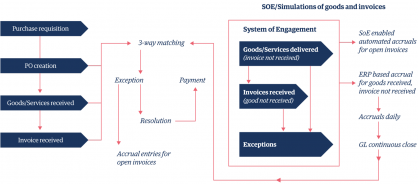- Point of view
Ecosystems of impact: A vision for CFOs
How to build a collaborative, competitive, connected enterprise

Leading CFOs are championing an enterprise that delivers a seamless experience for all key stakeholders – customers, employees, suppliers, and investors – and even society. Their vision offers a new data-driven way of working. One that connects people, processes, platforms, and data to unlock real-time insights, speed decisions, and spark action. The rear-view window of financial reporting is de-emphasized in favor of forecasting and predictive intelligence. And modern finance teams retain order and build resilience and agility in times of disruption while transforming into a transparent and vibrant strategic business partner that powers innovation and growth.
Connected and competitive
In a connected ecosystem, finance teams are free from the black box of their business, their sole role of reporting business transactions, and the eternal trap of the monthly race to the close. They use their unique views across the business to break down silos between functions, systems, and teams. And they achieve better ways of working through automation, artificial intelligence (AI), and advanced analytics.
Cloud-based systems help to harmonize, standardize, and democratize data, enabling AI and machine learning (ML) to deliver predictive and prescriptive insights. These machines augment human intelligence for faster, better decisions and pave the way to superior customer and employee experiences. Touchless processes and self-service insight dashboards are just the beginning of a digitally enhanced finance function that will one day exist inside the metaverse.
An enterprise that stays connected, collaborative, and close to its customers is competitive. But to realize its benefits, leaders across the business must embrace its possibilities, grasp the concepts that define it, and understand what steps to take to build and deliver it.
Take a copy for yourself
From data guardian to data orchestrator
The vision: Over the past five years, innovative, smart, and communicative technologies have evolved from the internet of things, blockchain, 5G, and now Web 3.0. A system architecture connected through a cloud-based ERP like SAP S/4HANA or hyperscalers like Microsoft Azure or Amazon Web Service (AWS) spans companies across the value chain and transforms the way we extract, mine, share, and interpret data. This seamless flow of data facilitates financial and operational planning, unlocks new sources of value, and drives better and faster decision-making. And as businesses adopt work-from-anywhere models, diverse and disparate teams can still connect.
The reality: CFOs now need to add the role of data orchestrator to data guardian and drive data convergence. Shift to a cloud-based ERP or hyperscaler to connect your systems and consolidate disparate sources and types of data. Gather and integrate information beyond the financial and transactional. Data from across the business, suppliers, partners, as well as external industry data and market intelligence, should all be pooled and processed in one place. And build AI and ML capabilities, such as natural language processing (NLP) and optical character recognition, to translate data into a common language.
Consider agile operating models, such as global business services or finance-as-a-service, which combine a robust cloud data fabric, best-in-class finance operations, and advanced technologies. These services become an extension of your business, offering a wider pool of expertise and capabilities, and they enable your finance teams to adopt a more strategic role.
Case study: Connecting collections in the cloud
For a leading healthcare device manufacturer, its contact center solution of 300 collections agents served 30 countries worldwide. But its legacy systems and processes meant the team struggled to get information in real time. This led to missed customer payments, cash flow disruption, and reduced productivity among frustrated employees.
Genpact helped move its invoice-to-cash function onto AWS and integrated the Amazon Connect contact center solution to smooth friction in its operations. AWS QuickSight offered an NLP solution to explore interactive financial dashboards and predictive insights on customer calls, improving the customer experience. Days sales outstanding reduced by 20 days, and IT infrastructure costs dropped by 75% along with license costs of $800,000 per year.
Case study: Data convergence driving sustainability
Let's think about data beyond financial reporting. As businesses join the race to become carbon neutral and champion ESG initiatives, CFOs are pivotal to determining new metrics to calculate impact and manage risk to make ESG more than just a pipe dream. Genpact worked with a Formula E racing team to automate how it collects and reports carbon emissions data, and maintain the team's certified carbon neutral status.
Connect people and processes to orchestrate data
The vision: A neural enterprise that stems from a single cloud-based operating environment connects intelligence across your business and every business with which you interact. Here, integrated software-as-a-service (SaaS) platforms encourage seamless interactions with audit trails and edge intelligence, harnessing the internet of things to get you closer to data at its source in real time. Finance and operations make quick critical decisions with confidence, spend less time on transactional tasks, and collaborate in the cloud with a common purpose. Barriers between teams are overcome, and boundaries between industries blur.
The reality: CFOs will have to take on the role of lead data orchestrator. And consider the following:
- Embedding a low-touch, AI-powered SaaS ecosystem of function-specific platforms that work together to smooth friction between functions, automate tasks at speed and scale, and augment human intelligence for more informed decision-making.
- Investing in analytics skills and capabilities such as data scientists and AI to enable real-time forecasts and predictive models. Predictive intelligence shared internally and externally can fuel think tanks and spark ideas
- Connect planning in the cloud and funnel business intelligence into an easy-to-digest dashboard. A single source of truth helps visualize and interpret business conditions and find better ways to work together and uncover new opportunities for growth
- Ensuring governance and controls to monitor risk and keep regulators happy. Automation means fewer manual touchpoints, better visibility, and an audit trail that reduces the need for controls. This transparency is critical for industries like manufacturing, consumer goods, and retail, which have vast supply chains
Case study: Pairing procurement with payables in the cloud
For a multinational consumer goods company, 70+ legacy systems, a failed enterprise software implementation, and siloed data meant the company's accounts payables function was not running smoothly. It was posting and paying half its invoices late and losing $9 million in potential discounts.
Genpact helped implement a standard operating environment and built a robust cloud data fabric to consolidate POs, receipts, invoices, vendor information, and contracted payment terms and discounts. It embedded intelligent automation to process data at scale, which resulted in 85% auto invoice posting, 95% of invoices paid on time, no credit holds, and a 200% improvement in supplier engagement.
Case study: Streamlining supply and cash flow management in the cloud
A retail major found itself struggling with its goods received, and incorrect inventory valuations were harming its retail margins. With around 7 million invoices processed manually each year, inaccurate payments were causing supplier disputes. And because 70% of disputes got paid back, relationships sustained unnecessary damage.
Genpact implemented a cloud-based ERP to help the company connect its systems and data and achieve greater visibility of its supply, inventory, and outgoing cash. We embedded intelligent automation to auto-match invoices to receipts and track payments to suppliers. And we built an ML model to quickly resolve exceptions and disputes. Disputes reduced by 40% and efficiency increased by as much as 70%.
Continuous systems, continuous insights
The vision: Businesses operate in highly dynamic and volatile environments. The traditional backward-looking view of financial reporting, with lags of 48 hours to 45 days, is no longer acceptable. In a connected ecosystem, CFOs use predictive accounting to close the books in real time and provide detailed forecasts for management. These predictive insights build business resilience, agility, and confidence in decision-making.
The reality: The technology to enable predictive accounting and continuous close is available now, but it means an upgrade in systems architecture to ensure data integrates seamlessly. When the foundations have been set, predictive accounting promises significant enhancements to decision-making wherever predictive insights are possible.
If we think about purchasing, predictive accounting delivers information, such as purchase orders, into an ML-enabled simulator that calculates highly accurate estimates to make predictive journal entries (figure 1).
Figure 1. Continuous close in accounts payable

These predictive entries allow for a continuous 'soft' close. Management can dip into key data on the outgoing cash position at any point and integrate it into daily strategic decision-making. Instead of a long, linear process, this predictive, real-time approach runs on a continuous loop. And with the right automation, the separate closing process ceases to exist – returning valuable insights and time to finance teams.
The future of finance in the metaverse
The vision: The metaverse – the ultimate ecosystem of impact, where 3D finance avatars connect with customers, colleagues, and suppliers in a radically different world to foster a culture of collaboration, innovation, and dare we say fun. Digitally engineered persona-based visual representations of data and simulated experiences and gamification build deep relationships and hyper-personalized self-service transactions. These low-touch AI-powered processes augment intelligence and make everyday tasks faster and decisions sharper.
The reality: You might well consider an early stake in the metaverse worlds of Decentraland or Sandbox, but for now CFOs can simply embrace the vision of a connected ecosystem and take concrete steps to deliver it.
Realize the vision
Connected ecosystems mean a new way of thinking and a new way of doing. Start with your vision and make a solid plan. Engage your teams, manage change, build skills and capabilities, and embed a collaborative culture. People are pivotal to turning your vision of a connected ecosystem into a reality.